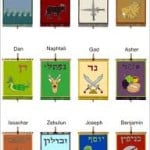Rabbi Chanan Morisson

Throughout their travels in the desert, the Israelites were commanded to set up their tents around tribal flags:
“The Israelites shall encamp with each person near the banner carrying his paternal family’s insignia. They shall encamp at a distance around the Communion Tent.” (Num. 2:2)
What is the significance of these banners?
The Midrash (Bamidbar Rabbah 2:3) says that the inspiration for the banners came from Mount Sinai. Twenty-two thousand chariots of angels, each one decked out with flags, attended the Revelation of the Torah. The Israelites immediately desired to have flags just like the angels, and God agreed. This request for flags, the Midrash teaches, is described in the Song of Songs (2:4): “He brought me to the wine-house, and His banner over me is love.”
From the Midrash we understand that banners relate to some inherent characteristic of angels, though not of people. But we are left with many questions. Why do angels bear flags? Why does the verse refer to Sinai as a ‘wine-house’? And what is the connection between banners and love?
The Specialized Service of Angels
According to the Zohar, the banners of the four major encampments (in each direction: north, south, east and west) corresponded to the four sides or ‘faces’ of the supernal merkavah (chariot) in Ezekiel’s mystical vision. Since these four ‘faces’ represent fundamental divine attributes, each encampment related to a particular divine quality.
Before we can explain the meaning of the flags and their connection to angels, we must first understand what an angel is. The Hebrew word mal’ach literally means ‘messenger.’ An angel is essentially a divine messenger meant to fulfill a specific mission. An angel cannot perform a task, important though it may be, other than the specific mission for which it was designated.
Now we can better understand the function of the angels’ flags. A banner proclaims a distinctive function or trait. Each angel, limited to a very specific area of divine service, carries its own distinguishing flag. These flags may be compared to military uniforms, where the dress and insignia indicate a soldier’s unit and assignment.
Human beings, on the other hand, are not limited to serving God in one particular manner. Our divine image encompasses all spiritual spheres (see Nefesh Hachaim 1:10). For us, a banner is too restricting; it does not reflect our true spiritual essence.
Nonetheless, the Jewish people saw in the angelic banners of Sinai an inspiring sight that appealed to them, albeit in a non-obligatory way. Every person has special talents and interests, based on individual character traits and his soul’s inner root. We are not limited in serving God in this particular way, but we are certainly more inclined towards those activities for which we have a natural proclivity. For example, a kind-hearted person may concentrate on serving God with acts of compassion and chesed; a strong-willed individual, with acts of courage and self-sacrifice; and so on.
The Jewish people desired flags like those the angels bore at Sinai. They wanted every individual to be able to choose an aspect of divine service that suits his personality, just as each angel executes a specific function, as defined by his flag.
The Wine-House
It is now clear why the verse refers to Mount Sinai as a ‘wine-house.’ Drinking wine releases our inhibitions, revealing our inner character. In the words of the Talmud (Eiruvin 65a), “Wine enters, secrets emerge.” The Israelites envied the beauty and joy they witnessed in divine service of the angels. The root of this pleasantness lies in the innate affinity the angels feel towards their service. Each angel naturally identifies with its particular mission. The Jewish people sought to uncover and emphasize every individual’s personal strengths, in the same way that wine liberates and highlights one’s inner characteristics.
This individualized worship, however, only applies to the service of the heart and the character traits. The banners reflect our feelings of love and joy when serving God — “His banner over me is love” — but the banners are not directly connected to the service itself. Within the framework of Torah study and practical mitzvot, there is no need for distinctive forms of service. Therefore, no banners flew over the central Communion Tent where the luchot (the stone tablets with the Ten Commandments) were stored, since the Torah and its mitzvot relate equally to all souls.
(Gold from the Land of Israel, pp. 227-229. Adapted from Midbar Shur, pp. 24-25)
Copyright © 2006 by Chanan Morrison
